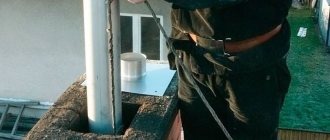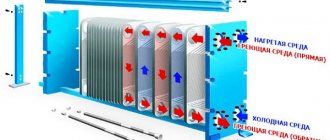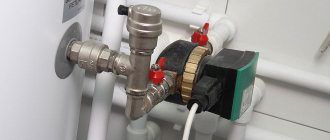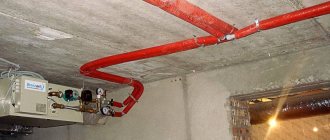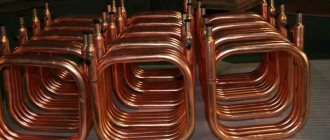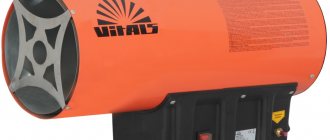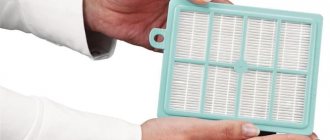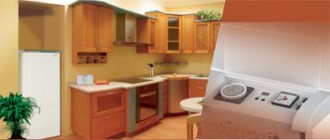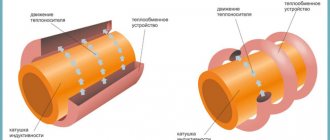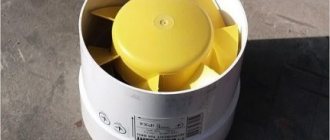Operating principle and design of a water heater
Universal devices operating on water are installed in places with a well-established heat supply system.
A simple but quite effective design solution allows you to heat air in the range from + 70? C to + 100? C and is relevant for hangars, gyms, supermarkets, greenhouses, warehouses, large pavilions - that is, large premises that require additional heating. If you have ever used a household heat heater, you will easily understand the principle of operation of a water device. It also heats the air, but the role of an electric spiral enclosed in a small housing is played by a set of metal tubes through which the heated coolant circulates.
The heating process is as follows:
- hot water, heated to the required temperature (on average from + 80? C to + 180? C), from the heating pipes enters a heat exchanger consisting of small aluminum, steel, bimetallic or copper tubes;
- the tubes heat the air passing through the device;
- The built-in fan distributes heated air throughout the room and stimulates its movement in the opposite direction - towards the device.
There is no need to specially heat the water, since it is part of the heating system, so significant cost savings occur.
The design of a standard water heater is a hybrid of a heat exchanger, fan and convector. It is effective for heating large industrial premises, and, when choosing the right piping, also for cottages with a well-established ventilation system.
Electric heater: operating features
Electric heaters are now successfully used to heat various premises, both residential and commercial and industrial. Considering that the source of energy is electricity, there are certain safety measures when using them. First of all, the presence of vapors from explosive objects, as well as conductive dust, should be excluded.
Electric heaters are mainly installed in spacious warehouses, workshops, halls, garages and drying chambers. They are available for vertical and horizontal installation. An important condition for safe operation is access to the system reboot panel in manual mode. Air heaters are especially popular and are successfully used on construction sites.
Electric heaters significantly speed up the drying process of various building materials, in particular plaster and paint. They are often used to form a thermal curtain at gates or door structures.
The wide temperature operating range allows its use in the temperature range from -30 to 50°C. To avoid overheating of the unit, care should be taken to ensure sufficient air flow, so it is necessary to first carry out the appropriate calculation. If used correctly and carefully, the heater can last quite a long time.
The heater can be used in the temperature range from -30 to 50°C
Helpful advice! When choosing an electric industrial heater, you must be extremely careful and take into account the size of the serviced area. It is also necessary to take into account that wall-mounted units are most often used, therefore, for safety reasons, care must be taken to securely fix them using special brackets.
Water heater: design features
A water heater for fresh air ventilation is economical compared to its electric counterparts: in order to heat the same volume of air, 3 times less energy is used, and the performance is much higher. Savings are achieved by connecting to a central heating system. Using a thermostat, it is easy to set the required temperature balance.
Automatic control improves efficiency. The supply ventilation control panel with a water heater does not require additional modules and is a mechanism for controlling and diagnosing emergency situations.
The composition of the system is as follows:
- Temperature sensors for street and return water, supply air and degree of filter contamination.
- Dampers (for recirculation and air).
- Heater valve.
- Circulation pump.
- Capillary antifreeze thermostat.
- Fans (exhaust and supply) with control mechanism.
- Exhaust fan control.
- Fire alarm.
Design of a water duct heater type 60-35-2 (size - 60 cm x 35 cm, row - 2) made of galvanized steel, intended for ventilation and air conditioning systems.
Water and steam heaters are presented in three varieties:
- Smooth tube: a large number of hollow tubes are located close to each other; heat transfer is small.
- Plate: Finned tubes increase the heat transfer area.
- Bimetallic: pipes and collectors are made of copper, aluminum fins. The most effective model.
Water heater: operating principle and purpose
Water heaters are used to heat air in various rooms where there is no central heating. They are also intended for ventilation or air conditioning systems. This type of air heaters is climate control equipment that serves as a heat exchanger filled with an intermediate coolant. The coolant in this equipment is heated or hot water.
Note! If the heater is used in a climate with an ambient air temperature below 0°C, the device must be equipped with special frost protection. Otherwise, frozen water in the pipes may simply rupture them.
A steam heater differs from a water heater in that dry saturated steam serves as the coolant in the device. These are more advanced models of heaters, so the price of a heater of this class is much higher.
The operating principle of a heating air heater: blue arrows - cold air, red arrows - warm air.
Types of heaters
The heater is installed directly inside the ventilation duct, so it must match the size and shape of the shaft. Depending on the coolant used in the heater, there are three types of heaters:
- Mermen.
- Steam.
- Electrical.
Mermen
Most often, rectangular heaters are found, but you can also choose a round model.
The device consists of rows of tubes, removable side panels and covers.
Water circulates through the tube system, but it can also be ethylene glycol.
Through the side holes, the size of which must be specified when purchasing, the unit is connected to the building’s heating system.
There are certain requirements for the air that passes through the heater:
- It must not contain solid particles, fibers or sticky substances.
- Dust content is less than 0.5 mg/m3.
- Minimum inlet temperature -20°C.
You also need to select a device based on productivity (in m3/h). If this indicator is insufficient, the heater will not warm the air and the rooms will be cold.
If for some reason it is impossible to install a heater of the required power, you can sequentially install a number of devices of lower power.
Steam
They are mainly used in industrial establishments where steam is a by-product of the production process. Steam heaters indicate the maximum permissible pressure they can withstand. Typically this is from 0.5 to 1.2 Pa.
Design of water and steam heaters
The same heater can be used for both steam and water.
There are three types of devices:
- Smooth tube.
- Lamellar.
- Bimetallic.
Peculiarities:
- Smooth tubes consist of many thin hollow tubes located close to each other. Minus: the heat transfer of the model is not great.
- Lamellar. Here the tubes are finned, which increases the heat transfer area. More effective than the first.
- Bimetallic ones have copper pipes and collectors, and the fins are made of aluminum. The most effective.
Electrical
Suitable for a small ventilation system - integrating such a unit into a ventilation system is much easier than a water unit. If energy costs are too high, there is an option to install an electric heater paired with a recuperator.
It is a spiral heating element in a housing. There is a built-in thermostat to protect against overheating.
Calorifiers (heat exchangers) description, types and advantages
The content of the article:
Description and application of heaters Varieties (types) of heaters Advantages of using a heater Design of a duct heat exchanger
Description and application of air heaters
A duct heater (an alternative name is a heater) is a device designed for heating premises by heating the supply air. The operating principle of the device is based on heating the air as it passes through a heat exchanger .
In this case, the temperature of the incoming air flow increases due to the transfer of thermal energy from the coolant. In practice, duct heaters are used as part of air heating , ventilation and air conditioning systems in industrial and utility premises. The most common objects of application are production workshops, hangars, warehouses for workpieces, equipment and finished products. In addition to direct heating functions, an example of the practical use of air heaters is their work as part of drying installations. The heating elements are fed by coolant, which enters the device through connection to centralized heating networks, water supply or electricity supply.
Varieties (types) of heaters
Duct heaters differ in two main indicators - the geometric shape of the body and the type of coolant used. Based on the body geometry, products in this category are divided into rectangular, round and square.
To heat the supply air flow, the devices use three types of coolants - water, steam and electricity. The heat exchangers themselves are classified depending on the type used .
Water heaters
The most common type of heat exchangers are KSk air heaters . The abbreviation KSk stands for “spiral-rolled heater”. The structural design of this type of product involves a tubular structure fixed in a sheet metal housing. The location of the pipes is across the direction of air flow. Depending on the required performance, models in the category are divided into heat exchangers with two, three and four rows of heaters. The latter are played by composite elements - steel tubes with aluminum fins applied to their outer surface.
Water circulates through the pipes from the bottom row to the top, which prevents airing in the pipeline. At the ends of the housing there are connecting flanges, the location of the holes in which corresponds to the connecting dimensions of the ventilation ducts .
Electric heaters
An electric-type duct heater involves heating the air using metal heating elements installed transverse to the flow direction, finned using incandescent filaments or spirally wound wire. Depending on the model, the number of heating elements in an electric heater varies from one to four.
The air pumped by the fan is forced onto the heating elements, which heat up under the influence of the voltage supplied from the mains. As a result, heated air flow is directed into the room, which ensures that a comfortable temperature is maintained. The required heating level is controlled and ensured using special temperature sensors that are installed indoors.
Steam heaters
This type of heat exchanger is designated by the abbreviation KPSk, which stands for “spiral-rolled steam heater.” KPSk heaters are similar in design and parameters to water heat exchangers. They also include a sheet metal body, end connection flanges and heating tubes.
The only difference is that in steam duct heaters, instead of water, hot water steam is supplied through the pipes, the temperature of which is +190 °C. The device is connected to a centralized steam supply system using inlet and outlet pipes, which are located on one of the sides of the housing.
Advantages of using a heater
Modern models of air heaters have many advantages over traditional methods of heating rooms. The list of advantageous characteristics includes the following factors:
- Economical consumption of coolant due to thermal energy recovery. Devices operating on the principle of heat recovery are responsible for controlling the incoming and outgoing air flow. In this case, the outgoing exhaust air flow transfers the accumulated thermal energy to the heat exchanger , which allows minimizing the consumption of coolant from the outside.
- Possibility of uniform heating of the internal volume of the room. Heaters are installed under the ceiling to eliminate the influence of air flows on the operation of equipment and personnel. The air is directed downwards using adjustable ventilation grilles installed at the end of the heaters . This allows you to balance the temperature in all points of the room.
- Possibility of automatic temperature control. heating on and off . This eliminates the possibility of equipment overheating and ensures that a comfortable room temperature is maintained.
- High performance heating elements. The fins of the heating elements provide an increased contact area of the heater with the passing air, which contributes to the rapid heating of the incoming flow.
In addition to this, it is worth noting that heaters have an increased safety and performance life, and are also easy to maintain and repair.
Duct heater design
The basis of the heater design is a body made of thin sheet metal, as well as metal tubes with fins. The number of rows of pipes can be 2, 3 and 4. More details on the design features and characteristics of duct heaters can be found in the sections TEW heat exchangers and KSK air heaters.
Design of duct heat exchanger
Heaters KSk and KPSk – size range
| Model range of 3/4 row water heat exchangers | |||||||
| Water heaters KSK 3 three-pipe | Water heaters KSK 4 four-pipe | ||||||
| Model | Weight | Weight | Model | Weight | Weight | ||
| KSk 3-1 | 31 kg | KSk 3-7 | 44 kg | KSk 4-1 | 37 kg | KSk 4-7 | 53 kg |
| KSk 3-2 | 35 kg | KSk 3-8 | 50 kg | KSk 4-2 | 42 kg | KSk 4-8 | 61 kg |
| KSk 3-3 | 39 kg | KSk 3-9 | 56 kg | KSk 4-3 | 48 kg | KSk 4-9 | 68 kg |
| KSk 3-4 | 44 kg | KSk 3-10 | 68 kg | KSk 4-4 | 53 kg | KSk 4-10 | 85 kg |
| KSk 3-5 | 56 kg | KSk 3-11 | 176 kg | KSk 4-5 | 66 kg | KSk 4-11 | 223 kg |
| KSk 3-6 | 38 kg | KSk 3-12 | 259 kg | KSk 4-6 | 45 kg | KSk 4-12 | 331 kg |
| Range of 3/4 row steam heat exchangers | |||
| Steam heaters KPSK 3 three-pipe | Steam heaters KPSK 4 four-pipe | ||
| KPSk 3-1 | KPSk 3-7 | KPSk 4-1 | KPSk 4-7 |
| KPSk 3-2 | KPSk 3-8 | KPSk 4-2 | KPSk 4-8 |
| KPSk 3-3 | KPSk 3-9 | KPSk 4-3 | KPSk 4-9 |
| KPSk 3-4 | KPSk 3-10 | KPSk 4-4 | KPSk 4-10 |
| KPSk 3-5 | KPSk 3-11 | KPSk 4-5 | KPSk 4-11 |
| KPSk 3-6 | KPSk 3-12 | KPSk 4-6 | KPSk 4-12 |
What is forced ventilation
Creating a comfortable indoor microclimate is an important task. Air ventilation is one of the components of this process. Supply ventilation in an apartment or house copes well with these tasks. Depending on the model, the device provides:
- purifying the air from various impurities;
- temperature change depending on the specified parameters;
- maintaining optimal humidity levels;
- creating comfortable living conditions.
Supply ventilation device
To increase the speed of exchange of air masses, various devices are used
When understanding what supply ventilation looks like, you need to pay attention to what elements it consists of:
- Fan
. The operation of the entire system depends on its power level. - Filters
. Protect the premises from contamination from the street. - A heating element
. Supply ventilation with heated air helps not to experience discomfort from temperature changes. - Recuperator
. The device is used to reduce the cost of heating air using room heat. - Sound absorption system
. To minimize sound from device operation. - Air ducts
. Prefabricated supply ventilation consists of pipes made of plastic or light metals. Specifications vary by model.
The principle of operation of supply ventilation
A characteristic feature of modern apartments is excessive sealing, so many are thinking about installing a forced air movement system. The supply ventilation system is ideal for this. It works like this:
- Air enters the air intake.
- Transported through an air duct thanks to the operation of a fan.
- After heating to the desired temperature, it enters the room.
30.06.2017
A short guide.
1. Design and principle of operation of the heater
Heating industrial premises is an important task in any production process. For these purposes, special heating equipment is used - air heaters. The operating principle of the air heater is simple: the incoming cold air, passing through the system of heat-transfer elements of the air heater, becomes warm at the outlet.
The heater consists of heat transfer elements, tube sheets, covers and removable side shields. For installation and fastening of heaters during installation, oval holes are provided on the sides of the tube sheets and removable shields.
The connecting dimensions of all heaters with a single pitch of 125 mm make it possible to assemble a heater installation with an air capacity of up to 500 thousand m³/hour.
2. Types of air heaters
When choosing a heater for an enterprise, you need to know that according to the heat source, they can be water, steam and electric. Each type of air heater has its own advantages and disadvantages, depending on operating conditions and purposes of use.
Electric heating units (EKU, SFOTs)
The electric heater installation is designed for heating premises for various industrial purposes. They are also used in construction: for drying and plastering building materials, paint and creating comfortable conditions when performing work. An important requirement when operating an electric heater is that the environment should not contain vapors of explosive substances or have a high concentration of conductive dust or humidity.
The advantage of electric heater installations is that they do not require additional installation of a water or steam heating system. A connection to electrical networks is sufficient. In addition, the electric heater installation can be mobile, which is convenient for local work.
However, such devices also have their disadvantages. Thus, an electric heater burns oxygen in the air during its operation. The air becomes dry. In addition, electric heaters are relatively expensive to operate due to energy consumption. Therefore, it is advisable to install this type of heaters in small rooms and during temporary local work. In large rooms (more than 100 sq. meters), it is better to install water- or steam-based air heaters.
Water (KSk, VNV) and steam (KP-Sk, VNP) heaters
Water and steam heaters are able to withstand large temperature ranges. The temperature of the coolant in such heaters reaches 180°C, and the pressure created by the pumps in the system is up to 1.2 MPa. Water and steam heaters are represented by metal pipes, which are covered with a ribbed outer surface, which allows increasing the area and efficiency of heat transfer. With the help of water and steam heaters, you can easily achieve the desired temperature in large rooms. Such a heating system is at the same time very economical, since the cost of expensive electricity during its operation is minimal. In addition, a big advantage of water and steam heaters is that they do not dry the air.
However, there are also disadvantages here. Thus, for the operation of water and steam heaters, it is necessary to connect to a source of hot water or steam, and therefore, the installation of a rather cumbersome water and steam supply system.
3. The production process of heaters (water, steam)
The quality of heat exchange equipment depends on the materials and technologies used in their production. If you are faced with choosing heating equipment from different manufacturers, be sure to pay attention to these production aspects. They will help you make informed choices.
First of all, you need to pay attention to the design of the heat-transfer element itself. They are spiral-rolled, plate-type and spiral-wound. Each has its own characteristics. Spiral-rolling manufacturing by rolling and extruding fins ensures tight and almost monolithic contact between the metal support pipe and the aluminum surface of the fins. Heaters with exactly this design of heat-transfer elements are produced at our enterprise. Spiral rolling devices are the best due to good contact between the aluminum and steel pipes. This improves heat transfer conditions. Spiral-knurled elements have a heat transfer coefficient 15% higher than competitors. In plate devices, ribs are mounted on tubes, and in spiral-wound devices, a steel tape is used to carry out the winding. In such structures, close contact between the pipe and the fins is not formed, and therefore their heat transfer coefficient is lower.
So, the first stage in the production of air heaters is the production of heat-releasing elements. For spiral-roll heaters, this is rolling an aluminum pipe onto a steel pipe. The first is put on the second, then the resulting “sandwich” is passed through special equipment, where under the action of a press the aluminum pipe turns into a spiral that sits tightly on the steel. The result is a finned heat-transfer element. The length of the heat-transfer elements can be up to 12 meters, depending on the customer’s needs.
Figure 1. Manufacturing of a finned heat transfer element.
Next, these elements are degreased and sent to the welding section, where they are connected to the grid. The gratings provide for the arrangement of pipes in two, three or four rows. Depending on this, the heater can contain from 26 to 142 elements and weigh more than 300 kg.
Figure 2. Collection of heat-transfer elements into grids.
Then comes the stage of welding the heat-transfer elements into grids. The welding stage is very important, since the tightness and durability of the heat exchanger itself depends on the quality of the welds. Welding can be carried out either manually or by a special robot. The productivity of a welding robot is higher and cheaper than manual welding. And the welds are perfectly smooth and sealed.
Figure 3. Operation of a welding robot.
Figure 5. Quality of welds.
After assembly, the heater is sent for hydraulic testing and then for painting. If necessary, the heater can be connected to a fan, resulting in another type of heating equipment - a heating unit.
Figure 6. Finished air heaters in the warehouse.
Thus, when choosing and installing air heaters for space heating, it is necessary to take into account a number of basic requirements in order to make the optimal choice:
1. For what purpose will the heater installation be used;
2. In what natural and climatic conditions will it be used;
2. What area of the room needs to be heated;
3. Which type of air heater best suits the functional and price requirements;
4. What materials and technologies are used in the production of heating equipment.
Guided by these criteria, you can choose the optimal heating equipment for your premises, which will provide warmth and trouble-free service for many years.
Review of modern models
To facilitate the selection and get an idea of water heaters from different manufacturers, the features and characteristics of several models will be described:
- The ZAO T.S.T plant produces heating devices for supply ventilation - KSK-3. The model is equipped with aluminum heating elements. Its body is made of carbon steel. These units operate with coolant in the following temperature range: from +70 degrees (outlet) to +150°C (input). The minimum air temperature in the supply air duct is -20 degrees. Maximum coolant temperature + 190 degrees. Working pressure is around 1.2 MPa. The working life declared by the manufacturer is 13.2 thousand hours, and the service life is 11 years.
- Volcano mini heat fans are compact in size and practical. They are produced by the Polish company of the same name. There are special blinds to change the direction of air flow. Power is 3-20 kW, productivity is 2 thousand cubic meters per hour. The unit has a double-row heat exchanger with protection class IP 44. The maximum operating pressure is no more than 1.6 MPa, and the maximum coolant temperature is +120 degrees. The heat exchanger volume is 1.12 liters. Suitable for heating air in industrial and domestic premises.
- Italian water heaters Galletti AREO work for heating and cooling air masses. They are equipped with a heat exchanger consisting of copper-aluminum tubes, a fan and a drainage tray. Power ranges from 8-130 kW. When operating in cooling mode, this figure is 3-40 kW. Working pressure – 10 bar. Coolant temperature +7…+95°С. The unit heats the air to +40 degrees or cools it to +10°C. Protection class – IP 55. Electric motor protection is provided.
Also on the trading market of industrial heating equipment are models of the following brands: Teplomash, Fraccaro, 2VV, Yahtec, Kroll, Tecnoclima, Pakole, Remko, Innovent, Zilon.
Design of different types of air heaters
A heating water heater consists of a housing made of metal, a heat exchanger placed in it in the form of a series of tubes and a fan. At the end of the unit there are inlet pipes through which it is connected to a boiler or centralized heating system.
As a rule, the fan is located at the back of the device. Its task is to drive air through the heat exchanger.
After heating, the air flows back into the room through the grille located on the front part of the heater.
Most often, the housing is made in the shape of a rectangle, but there are models designed for round ventilation ducts. Two- or 3-way valves are installed on the supply line to regulate the power of the unit.
The fan blows through the tubes located in the heater housing. Heated water from the heating system moves through the tubes, and the fan distributes warm air evenly throughout the room
Air heaters also differ in the method of installation - they can be ceiling or wall mounted. Models of the first type are placed behind a false ceiling, only the grille looks beyond it. Wall mounted units are more popular.
Type #1 – smooth-tube heaters
The smooth-tube design consists of heating elements in the form of thin hollow tubes with a diameter of 20 to 32 mm, located at a distance of 0.5 cm relative to each other. Coolant circulates through them. The air, washing the heated surfaces of the tubes, is heated due to convective heat exchange.
The tubes in the air heater are arranged in a checkerboard or corridor pattern. Their ends are welded into the collectors - upper and lower. The coolant enters the distribution box through the inlet pipe, then, after passing through the tubes and heating them, it exits through the outlet pipe in the form of condensate or chilled water.
More stable heat transfer is provided by devices with a staggered arrangement of tubes, but the resistance to air flows is higher here. It is necessary to calculate the power of the unit in order to know the real capabilities of the device.
There are certain requirements for the air - there should be no fibers, suspended particles, or sticky substances. Permissible dust content is less than 0.5 mg/mᶾ. Inlet temperature is at least 20⁰.
Single-pass and 3-pass heaters. 1 – inlet pipe through which the coolant flows, 2 – distribution box, 3 – tube, 4 – outlet pipe, 5 – partition
The thermal characteristics of smooth-tube heaters are not very high. Their use is advisable when significant air flow and heating to a high temperature are not required.
Type #2 – finned air heaters
The pipes of finned devices have a ribbed surface, therefore, the heat transfer from them is greater. With fewer pipes, their thermal characteristics are higher than those of smooth-tube air heaters.
Plate heaters include tubes with plates mounted on them - rectangular or round.
The first type of plates is mounted on a group of pipes. The coolant passes into the distribution box of the device through a fitting, warms up the air passing at a significant speed through channels of small diameter, and then exits the assembly box through the fitting.
Heaters of this type are compact, easy to maintain and install.
Single-pass plate devices are designated: KFB, KFS, KVB, STD3009V, KZPP, K4PP, and multi-pass plate devices are designated as KVB, K4VP, KZVP, KVS, KMS, STDZOYUG, KMB. The middle model is designated KFS, and the large one is designated KFB.
A corrugated steel tape 1 cm wide and 0.4 mm thick is wound onto the tubes of these heaters. The coolant for them can be either steam or water.
Water heaters cannot be connected with metal-plastic or polymer pipes because They are not designed for high coolant temperatures. We need steel pipes and preferably galvanized ones to prevent corrosion
The first is equipped with three rows of tubes, and the second with four. The plates of the medium model have a thickness of 0.5 mm and dimensions of 11.7 x 13.6 cm. The plates of the large model of the same thickness and width are longer - 17.5 cm.
The plates are located at a distance of 0.5 cm from each other and have a zigzag arrangement, whereas in the middle-type models the plates are arranged according to the corridor principle.
Air heaters marked STD have 5 numbers (5, 7, 8, 9, 14). In STD4009V heaters the coolant is steam, and in STD3010G it is water. The installation of the former is carried out with a vertical orientation of the tubes, the latter - with a horizontal orientation.
Type #3 – bimetallic heaters with fins
In heating systems with heated air, models of bimetallic heaters KP3-SK, KP4-SK, KSk - 3 and 4 with a special type of fins - spiral-rolled - are often used. The coolant for heaters KP3-SK, KP4-SK is hot water with the highest pressure of 1.2 MPa and maximum temperature of 180⁰.
To operate the other two air heaters, steam is required with the same operating pressure as for the first ones, but with a slightly higher temperature - 190⁰. Manufacturers must carry out acceptance tests. The devices are also tested for leaks.
The heat exchanger of the KSK air heater consists of tubes made of steel and having aluminum fins. Tube sheets connect them
There are 2 lines of bimetallic air heaters - KSK3, KPZ, which have 3 rows of tubes, are medium-sized, and KSK4, KP4 with 4 rows of tubes are large models. The components of these devices are bimetallic heat exchange elements, side shields, tube grilles, and covers with partitions.
The heat exchange element consists of 2 tubes - an inner one with a diameter of 1.6 cm, made of steel and an aluminum outer one with fins mounted on it. The transverse spacing between the heat transfer tubes is 4.15 cm, and the longitudinal spacing is 3.6 cm.
Electrical devices
Electric heaters for fresh air ventilation are very effective, but quite expensive heating devices.
The temperature in the ventilation duct increases as a result of air coming into contact with hot spirals or plates made of refractory types of metals. An increase in the temperature of the heating elements occurs due to a change in the electrical resistance of the heaters. This requires quite a lot of electrical energy.
The degree of heating of the coil or plate is directly proportional to the strength of the current that flows through the element. By increasing the voltage, you can decrease the current without changing the electrical power.
Advantages and disadvantages of electric heaters
Among the main advantages that characterize an electric heater, it is worth highlighting the following.
Simple installation process. Thus, it is much easier to connect a cable to the heater than to circulate water or other coolant inside it.
You don't have to worry about providing thermal insulation to the wiring. The power loss in the cable due to electrical resistance is much lower than the heat loss in any pipeline with coolant fluid.
Easy adjustment of suitable air temperature. To be able to set the temperature of the air supplied to the room at the required level, it is enough to install a simple temperature sensor in the power circuit of the heating device. In the case of a water heater, coordination of the boiler power, coolant temperature and air temperature will be required.
At the same time, the electric type of devices also has its disadvantages. First of all, this is the cost of the device, which is higher in comparison with water analogues. So, in the case of approximately the same power level, the price of an electric heater will be approximately 2 times higher than a device with a liquid coolant.
Quite high energy costs. Thus, to ensure heating of the air in the ventilation system of even a small room, electricity costs will be significant.
Water devices
The second type of ventilation heaters, water heaters, provide an increase in the temperature of the air supplied to the ventilation duct due to the transfer of thermal energy from the coolant that circulates inside the radiator of the device.
Liquid as an air heater is practically in no way inferior to its electric counterparts, but does not require much energy consumption.
But unlike an electric type device, water ones are quite difficult to install, so it is quite difficult to install them yourself.
Pros and cons of water heaters
Among the advantages that water air heaters have in ventilation systems, the most important is their high efficiency even in large areas.
This is ensured by the design features of the device, since the air in it is heated in a plane perpendicular to the air flow.
The most important disadvantage of a water heater is the high probability of freezing of the device in severe frosts, since the principle of its operation is based on the flow of water inside the radiator. That is why heaters of this type must have protection against possible icing.
What is supply ventilation with air heating
Complete set of compact heated ventilation for an apartment
Ventilation with a heat exchanger provides a continuous supply of heated fresh air flow. This creates a good microclimate. Ventilation providing heating of incoming air masses includes: central supply and exhaust equipment with a recuperator, which provides heating of air coming from the street. This occurs due to the temperature of the exhaust air being removed. The recuperator, passing air, does not mix it with the exhaust air masses. That is, air enters and exits through individual channels, the walls of which are located end-to-end.
Heating of the supply ventilation can be carried out using recirculation (air conditioners, heaters). Warm “exhaust air” is mixed with supply air, which is heated to the desired temperature and then supplied to the room.
Types of supply ventilation
These indoor air movement systems are classified according to a number of characteristics. According to the design of the ventilation network, the system is:
- Team
. When individual elements are connected using air ducts. - Monoblock supply ventilation
. In this option, most of the elements are combined in one housing.
According to the ventilation method, the supply system is divided into: local, complex and emergency. Based on the presence or absence of an air duct, the classification is:
- Ductless
. When fresh air enters the room through the supply opening. - Duct
. The supply occurs through an air duct system.
Ductless ventilation
The device ensures the injection of clean air into the room due to the operation of the supply unit, due to which the effect of an air curtain or oasis is formed in the intended area of the room. Ductless supply ventilation ensures the removal of contaminated air through a special hole or gap in the door and window. If you have a powerful fan that makes a lot of noise, it must be supplemented with a noise suppressor. Depending on the degree of complexity, supply ventilation is a device that is divided into three types:
- window valve
; - supply fan
; - Supply unit
.
In installations, a filter is installed to filter out impurities, and an air intake grille is installed to protect against debris. Supply and exhaust ventilation for an apartment can be equipped with a system for heating the incoming air; for this, a special element is used that prevents the temperature in the room from falling below a predetermined level. Each owner chooses one or another type for himself, depending on the final purpose of the acquisition and financial capabilities.
Duct ventilation
These devices are a set of air ducts that connect all rooms. What distinguishes them is the need for periodic maintenance to maintain quality of operation. Ducted supply ventilation has one drawback - a large network of air ducts that need to be hidden by the ceiling. This must be taken into account and installation done at the stage of renovation of the premises. The principle of operation of the system is simple - fresh air enters the room through the channels and with its flow displaces the exhaust air through the air intakes.
Often such forced ventilation is installed at large facilities, where heating requires large energy consumption. In order to lower them you can set:
- recuperator;
- water heater;
- VAV system.
Water heaters with a fan: characteristics and manufacturers
A water heater with a fan is one of the most economical and efficient devices used for heating air in hangars, warehouses, gyms, shopping, exhibition and concert halls, car service centers, and workshops. It is also used to heat greenhouses, farms and other spacious objects with a large area.
Such units also come in different designs depending on the intended placement. That is, there can be wall or ceiling heaters that can be easily installed in any room.
The main advantages of water heating coils are their energy efficiency and performance, which is manifested in the ability to both increase and cool the temperature in the room. At the same time, fan heaters are generally low-cost, since they consume little electricity and allow you to save on heating.
Electric fan heater with Flowair control panel
Both foreign and domestic brands specialize in the production of such air heaters, including Teplomash, Greers, Flowair and Volcano. A water heating coil with a fan is an excellent solution in most cases for heating large objects.
KSK air heaters are considered popular in the domestic market. Devices of this brand are compact and economical. The units are widely used in industry, as they do an excellent job of quickly heating air in large areas, while using a minimum of electricity. The devices are also used as a heat exchanger. They are a component in various units, heating, air conditioning and ventilation systems. The coolant in the KSK heater is hot water with a temperature of over 190°C.
Heating coils with fans: design and operation features
Heating coils with fans are available in six standard sizes. These are very popular heating products, therefore they have a wide range of models from many manufacturers. There are two-row and three-row models. Heater power from 10 to 60 kW allows you to select equipment for rooms of different sizes.
Interesting to know! Modern fan heaters are characterized by a low noise level, which at a five-meter distance from the unit when operating at full power does not exceed 55 dB. When the fan speed is reduced, the noise level is reduced to 30 dB.
The power of heaters varies between 10-60 kW
Such heaters are also called fan heaters or duct heaters; they are compact and lightweight. They are mounted on the ceiling or wall using special brackets.
For wear resistance, the unit body is made of polypropylene or galvanized steel, and the top is coated with enamel. Polypropylene is characterized by a high degree of resistance to mechanical damage and resistance to various gases and vapors. Therefore, the housing can withstand high temperatures and is resistant to corrosion and damage of various types.
Copper tubes are used to produce the heat exchanger, and aluminum plates are used for fins. They are mounted on the rear panel of the device, which greatly simplifies the installation of the device and improves its design.
The device is equipped with a silent axial fan with blades made of a special profile and bearings of the highest class that do not require lubrication. This device provides high performance with low power consumption. In addition, the air flow is adjustable within the operating range. Water from the central heating system serves as the coolant.
The units are produced in ceiling and wall versions. Due to the lightness of the mounting console, the unit can be rotated 180 degrees during operation.
Ceiling heating fan heater
Calculation of heater power
Let's determine the initial data that will be needed to correctly select the heater power for ventilation:
- The volume of air that will be distilled per hour (m3/h), i.e. the performance of the entire system is L.
- Temperature outside the window. – tul.
- The temperature to which the air needs to be heated is tcon.
- Tabular data (air density at a certain temperature, heat capacity of air at a certain temperature).
Instructions for calculation with example
Step 1. Air flow by mass (G in kg/h).
Formula: G = LxP
Where:
- L – air flow by volume (m3/h)
- P – average air density.
Example: Air coming in from the street is -5°C, and at the outlet the required temperature is +21°C.
Sum of temperatures (-5) + 21 = 16
Average value 16:2 = 8.
The table determines the density of this air: P = 1.26.
| Air density depending on temperature kg/m3 | ||||||||||||||||||||||||||
| -50 | -45 | -40 | -35 | -30 | -25 | -20 | -15 | 10- | -5 | +5 | +10 | +15 | +20 | +25 | +30 | +35 | +40 | +45 | +50 | +60 | +65 | +70 | +75 | +80 | +85 | |
| 1,58 | 1,55 | 1,51 | 1,48 | 1,45 | 1,42 | 1,39 | 1,37 | 1,34 | 1,32 | 1,29 | 1,27 | 1,25 | 1,23 | 1,20 | 1,18 | 1,16 | 1,15 | 1,13 | 1,11 | 1,09 | 1,06 | 1,04 | 1,03 | 1,01 | 1,0 | 0,99 |
If the ventilation capacity is 1500 m3/h, then the calculations will be as follows:
G = 1500 x 1.26 = 1890 kg/h.
Step 2. Heat consumption (Q in W).
Formula: Q = GxС x (tcon – tul)
Where:
- G – air flow by mass;
- C – specific heat capacity of air entering from the street (tabular indicator);
- tcon – temperature to which the flow needs to be heated;
- tul – temperature of the flow entering from the street.
Example:
Using the table, we determine C for air with a temperature of -5° C. This is 1006.
| Heat capacity of air depending on temperature, J/(kg*K) | ||||||||||||||||||||||||||
| -50 | -45 | -40 | -35 | -30 | -25 | -20 | -15 | 10- | -5 | +5 | +10 | +15 | +20 | +25 | +30 | +35 | +40 | +45 | +50 | +60 | +65 | +70 | +75 | +80 | +85 | |
| 1013 | 1012 | 1011 | 1010 | 1010 | 1009 | 1008 | 1007 | 1007 | 1006 | 1005 | 1005 | 1005 | 1005 | 1005 | 1005 | 1005 | 1005 | 1005 | 1005 | 1005 | 1005 | 1006 | 1006 | 1007 | 1007 | 1008 |
Substitute the data into the formula:
Q = (1890/3600*) x 1006 x (21 – (-5)) = 13731.9** W
*3600 is the hour converted to seconds.
**The resulting data is rounded up.
Result: to heat air from -5 to 21 °C in a system with a capacity of 1500 m3, a 14 kW heater is required
There are online calculators where by entering performance and temperatures you can get an approximate power indicator.
It is better to provide a power reserve (5-15%), since equipment performance often decreases over time.
Heating surface calculation
To calculate the heated surface area (m2) of a ventilation heater, use the following formula:
S = 1.2 Q: (k (tliquid – tair)
Where:
- 1.2 – cooling coefficient;
- Q – heat consumption, which we have already calculated earlier;
- k – heat transfer coefficient;
- tliquid – average temperature of the coolant in the pipes;
- tair is the average temperature of the flow coming from the street.
K (heat transfer) is a tabular indicator.
Average temperatures are calculated by finding the sum of the incoming and desired temperatures, which must be divided by 2.
The resulting result is rounded up.
Knowing the surface area of the heater for ventilation may be necessary when selecting the necessary equipment, as well as for purchasing the required amount of materials when independently manufacturing system elements.
Features of calculating steam heaters
As already mentioned, the heaters are used the same for water heating and for the use of steam. Calculations are carried out using the same formulas, only the coolant flow is calculated using the formula:
G=Q:m
Where:
- Q – heat consumption;
- m is an indicator of the heat released during steam condensation.
And the speed of steam movement through the pipes is not taken into account.
What to look for when choosing a duct dehumidifier
The main parameter that characterizes a duct dehumidifier is its productivity, measured in liters per day. In other words: productivity is how many liters this model can “squeeze” out of the air in 24 hours.
For a private house with a small pool, a device that removes 10-50 liters of moisture per day may be sufficient. For large multi-storey buildings with a pool surface of 25-100 m2, a capacity of up to 350 liters may be needed. water in 24 hours.
In addition to performance, in equipment documents the manufacturer usually indicates:
- How much space is the device designed for?
- Dimensions of the installation and its functionality.
- Dimensions of cross-section of pipes for connecting air ducts.
Calculation of heater power
To carry out the calculation, the following data is required:
- Volume or mass of supply air to be heated. It can calculate volume flow (cubic m/h) or mass flow (kg/h).
- The initial air temperature, which is equal to the outside air temperature.
- The target temperature to which the supply air must be heated before being supplied to the premises.
- The temperature regime of the coolant, which is used to heat the air.
Instructions for calculation
When calculating the heater used for supply ventilation, it is necessary to calculate the heating surface area and the required power. You need to start by calculating the cross-sectional area of the heat exchanger along the front:
Af = Lρ / 3600 (ϑρ), here:
- L – supply air flow rate by volume, m³/h;
- ρ – value of the density of external air, kg/m³;
- ϑρ – mass velocity of air masses in the design section, kg/(s m²).
Calculation of heater power
The frontal cross-section indicator is necessary for awareness of the size of the heat exchanger. Next, you need to use the nearest larger device for the calculation. If, according to calculations, the cross-sectional area is too large, you will need to opt for several heaters mounted in parallel to obtain the required area.
The real mass velocity indicator must be calculated taking into account the actual front area of the selected heaters:
ϑρ = Lρ / 3600 Af.fact
Next, the required amount of heat to heat the air flow is calculated using the formula:
Q = 0.278Gc (tп – tн), where:
- Q – amount of heat, W;
- G – mass flow of heated air, kg/h;
- c – the specific heat capacity of the air mixture is taken to be 1.005 kJ/kg °C;
- tп – inflow temperature, °С;
- tн – initial air temperature from the street.
Since the fan is installed in the supply ventilation before the heat exchanger, the mass flow G is calculated taking into account the air density outside. G = Lρн
G = Lρн
Otherwise, the density is determined by the temperature of the air after it is heated. The calculated amount of heat allows us to calculate the coolant costs in the heater (kg/h) to transfer this heat to the air being passed through:
Gw = Q / cw (tg – t0)
In this formula:
- cw – heat capacity value for water, kJ/kg °C;
- tg – design temperature of water in the supply pipeline, °C;
- t0 – design water temperature in the return pipeline, °C.
The specific heat capacity of water is a reference indicator. The temperature characteristics of the coolant used for calculations are taken based on real indicators under existing conditions. If there is a boiler room or connection to a central heating network, the characteristics of their coolants will be needed for the calculation. Having information about the coolant flow rate, you can calculate the speed (m/s) of its movement through the heater pipes:
w = Gw / 3600 ρwAmp, here:
- Amp – cross-sectional area of the heat exchanger tubes, m²;
- ρw – density of water at the average temperature of the coolant in the heater, °C.
Calculation of the average temperature of water circulating through the heater is carried out using the formula:
(tg + t0) / 2
The speed calculated using the above formula will be valid for a set of heat exchangers connected in series. If parallel piping is performed, the cross-sectional area of the pipes will more than double. In turn, this will cause a decrease in the speed of movement of the coolant. Such a reduction will not bring an increase in productivity, but will cause a decrease in temperature in the return pipeline. In order not to encounter an excessive increase in the hydraulic resistance of the heat exchanger, it is not necessary to accept a coolant movement speed of more than 0.2 m/s.
Pros and cons of heating with a heater
A home heating system, based on supplying air heated to a set temperature directly into the house, is of particular interest to homeowners.
This heating system design consists of the following important components:
- a heater acting as a heat generator that heats the air;
- channels (air ducts) through which heated air masses enter the house;
- a fan that directs well-heated air throughout the entire room.
There are many advantages to this type of system. These include high efficiency, the absence of auxiliary elements for heat exchange in the form of radiators, pipes, and the ability to combine it with a climate system, and low inertia, as a result of which large volumes are heated very quickly.
Image gallery Photo from Heater - a heating device designed only for processing the air flow without changing the humidity of the processed mass. Heaters are equipped with air heating and air conditioning systems that mix a fresh portion of air from the street to the flow circulating inside. In air heating systems, the air heated by the heater is forced into the room using a fan. A significant plus The use of air heaters is considered to be their ability to quickly heat large areas and volumes of premises, including workshops, shopping malls, warehouses. Equipment for air heating Air conditioning system with air heater Air heating with air heater Fast heating of large areas
For many homeowners, the disadvantage is that installation of the system is only possible simultaneously with the construction of the house itself and then further modernization is impossible.
The downside is such a nuance as the mandatory presence of backup power and the need for regular maintenance.
The heater is easy to install and operate, is affordable, but most importantly, it is an effective device for heating a room. The photo shows a water heater built into the system
On our website there are more detailed materials on the installation of air heating in a house and cottage. We recommend that you familiarize yourself with them:
- Do-it-yourself air heating: everything about air heating systems
- How to arrange air heating for a country house: rules and construction plans
- Calculation of air heating: basic principles + calculation example
Local ventilation
This type of ventilation works on the principle of exhaust systems. Types of local ventilation (supply and exhaust) involve the extraction of air directly from the place of formation of harmful substances. This allows you to stop their spread throughout the room, localize and remove them.
It is worth noting that modern local ventilation systems are specially equipped with powerful filters due to the nature of their application. This solution allows you to purify the air up to 98% and reuse it in the future.
In rooms where various types of work or food preparation are carried out, mixed air exchange systems are often created. They represent general ventilation of one of the above types, and local ventilation, which prevents substances from evaporating and spreading throughout the room.
Depending on the design, ventilation systems can also be either ducted or non-ducted. The first type involves the installation of branches that are spread throughout the building. It has one or two inputs and one output. The second type assumes the absence of channels, and the systems themselves are built into walls or floor slabs.
Principle of operation
Heated supply ventilation is very simple in operating principle. At the first stage, air is drawn in through the air intake and filtered from large debris and insects. After this, air is transferred directly to the device body.
At the next stage, the incoming air is specifically purified from all small particles. To do this, there are several thin filters in the inlet for varying degrees of purification.
After thorough cleaning, the air flows directly to the heating elements. If the device has the ability to control heating, then it occurs only within the specified parameters. After heating, another cleaning process starts, during which the air is freed not only from dust, but also from pollen, other allergens and odors.
As a result, purified and sufficiently warm air enters the room, the temperature of which can be controlled from the control panel.
Operating conditions and features
The water heater is connected to the DHW pipe and the return line.
The operating principle of a water heater for heating, equipped with a fan, is based on the heat exchange of two working media. Hot water is used as the primary coolant, air is used as the secondary coolant. Heating of air masses is carried out by transferring the heat of hot water to the cold air flow. The efficiency of heat transfer depends on the temperature difference - it must be large.
When operating the devices, several requirements must be met:
- Before installation in a large room, performance indicators are calculated.
- Household models are compact and compatible with steam or water heating.
- The use of water with a temperature of more than 180 degrees in the mains is unacceptable - the heater will fail.
- For large rooms, a heater power control system is used in the form of a mixer with a three- or two-way valve.
- The maximum density of aggressive impurities in the air during operation of the device is specified in GN 2.2.5.686-98 and GOST 12.1.007-76.
- The energy efficiency of the heater depends on the heat transfer coefficient. The value is indicated in the passport.
- Before installation in a home workshop or garage, it is necessary to install filters to remove chemical impurities.
- Three-row models are suitable for ventilation communications that supply outside air at temperatures from 0 to -40 degrees.
- Four-row modifications are launched in winter only at a rate of temperature increase of up to 30 degrees per hour.
- The units are not suitable for forced or artificial ventilation - they pump air through duct elements.
Choosing a location for installing supply ventilation
Depending on the type of supply ventilation system and its purpose, the location for installation is selected. More details about each variety:
Monoblock designs
Monoblock-type systems are installed, as a rule, in the attics of residential buildings, and the shafts are located under the ceiling, which makes it possible to hide them when finishing the room.
In production workshops, installation takes place in specially designated rooms with an extensive communications network throughout the building.
Prefabricated
They are usually installed according to the building design, which specifies in detail the installation location of each system and the laying of air lines. Due to the size of the installation, its installation is possible either under the ceiling, in which case communications can be hidden during finishing, or along the outer wall of the room.
Regardless of the type of installation, the liquid-type heater part is connected to the heating system.
There is also a difference in the installation of structures that differ in the method of ventilation.
General exchange
Just like other types, it is installed at the stage of rough work according to the house design. Communications are laid under the ceiling of the rooms. Supply air ducts are brought closer to the floor. In the kitchen it could be a stove hood, in the bathroom it could be a ceiling fan.
Local
Local ventilation systems can be installed both during rough work and after finishing is completed. Some types of air supply devices can be mounted on a window vent. For wall installation, a hole is sometimes made in the wall of the room.
Prefabricated local ventilation systems are installed under the ceiling or in the walls of the room. This makes it possible to carefully cover communications with finishing materials.
Specifics of using water heaters for heating
Water-type fan heaters are used for heating large premises - shops or offices. They allow you to quickly dry carpets or car seats, so they can be used in car washes and dry cleaners.
Water heat sources are justified for basement floors with high humidity levels. They can be installed in garages, construction cars, workshops, on the territory of warehouses or workshops for the production of polymers.
Duct water heaters are suitable for maintaining a comfortable temperature in the home and at work. Energy-saving equipment consumes virtually no electricity and gas, which allows you to save on utility bills.
Selection of air exhaust equipment
a kitchen hood can be an interior decoration
We will remove air from the most “polluted” rooms: the bathroom and kitchen, using a time-tested exhaust fan.
Choose exhaust fans equipped with humidity and motion sensors. Such devices do their job better using less electricity.
A fan is installed instead of the exhaust grille. It is advisable to equip the hood with a check valve. This inexpensive device is a plastic curtain on a horizontal axis shifted upward. The valve blocks air flow from the ventilation system, preventing reverse draft.
If the fan is equipped with sensors, electric current is supplied to it continuously. Simpler models are powered from a light switch or activated by a separate button. The second option for the kitchen is preferable.
It is impossible not to mention a device that is widely used to remove exhaust air - a kitchen hood. The effectiveness of the hood is explained by the fact that it captures vapors and odors directly in the area where they appear
When choosing, you should pay attention to the following parameters:
- type (flat, island, dome, built-in);
- dimensions;
- operating principle (air recirculation or exhaust);
- performance;
- noise level;
- control method (touch or mechanical).
| Model | Type | Operating modes | Productivity (cub.m/h) | Power , W) | Control type |
| Hansa OKS 653 SWN | domed | Exhaust\ circulation | 620 | 160 | Sensor |
| Hotpiont HLB 6.7 | built-in | Exhaust\ circulation | Buttons | ||
| Elikor 60 IX | domed | retraction | 430 | 185 | Buttons |
| Cata CN-600 | domed | Exhaust\ circulation | 583 | 80 | Buttons |
| Snindo Avior 60 SS\BG | domed | Exhaust\ circulation | 800 | 238 | Sensor |
| Krona Kamilla 2M | built-in | Exhaust\ circulation | 550 | 200 | Buttons |
| Gorenie WHT961 | domed | Exhaust\ circulation | 755 | 288 | Sensor |
| Samsung HDC9A90 | domed | retraction | 861 | Sensor |
Table 2. Characteristics of some models of kitchen hoods
By installing exhaust devices, you get supply and exhaust ventilation with mechanical drive and heating.
